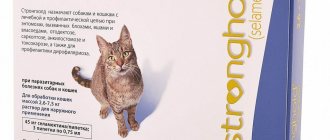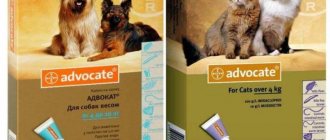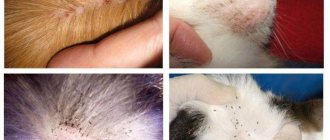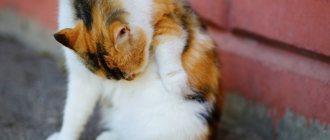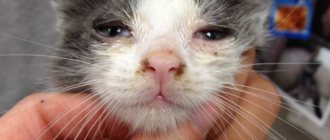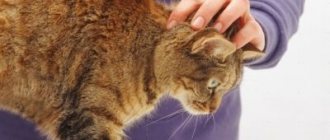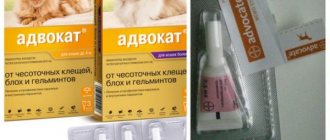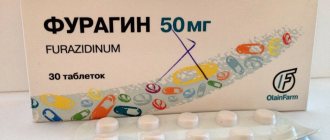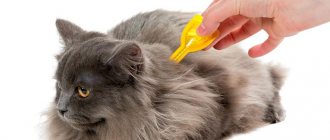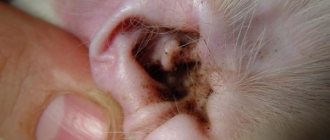Description of the drug
The developer of the drug Inspector Total is the German company Veterinary Bio UG. The form of the medicine is drops for external use. Externally, the product is an oily liquid of a light yellow hue.
Inspector belongs to the category of combination antiparasitic drugs. There are two types of medicine - for cats and dogs. Who the drops are intended for can be determined by the letter after the name Ispector Total. K is drops for cats, C is for dogs.
Inspector
Effect of the drug
The combined antiparasitic drug has an effective effect on a number of parasites:
- Vlasoedov.
- Bloch.
- Lice.
- Ixodid, demodectic and sarcoptoid ticks.
- Sexually mature nematodes and their larvae.
- Microfilaria larvae.
The mechanism of action of the drug lies in its effect on the nervous system of parasites. First, the GABA-dependent receptors of arthropods are blocked, the transmission of nerve impulses is disrupted, paralysis develops, which ultimately leads to the death of ectoparasites.
Thanks to the presence of two active substances in the preparation, Inspector not only quickly eliminates existing parasites, but also protects the dog for quite a long time. Moxidectin has a direct effect on the nervous system of the ectoparasite and is absorbed into the animal’s bloodstream. In contrast, Fipronil remains almost completely on the dog’s fur and skin, providing a contact insectoacaricidal effect.
Composition and release form
The main active ingredients of the drops are:
- fipronil is a strong insectoacaricide;
- Moxidectin is a semi-synthetic substance from the group of macrocyclic lactones.
In addition to them, the Inspector includes:
- polyethylene glycol;
- butylhydroxyaiisole;
- butylated hydroxytoluene;
- diethylene glycol monoethyl ether.
The drops are poured into disposable polymer pipettes of various capacities:
- for cats – 0.4 and 0.8 ml;
- for dogs – 0.4; 1.0; 2.5; 4.0 ml.
Each pipette is packaged in a polymer blister, which is placed in a cardboard box along with instructions.
Composition and pharmacological action
The formulation of Inspector Total K and Inspector Total S drops, as well as the spray, is not the same, see table:
| Component | Content of active substance,% | ||
| Inspector Total K | Inspector Total S | Inspector spray | |
| Fipronil | 10 | 10 | 0,4 |
| Moxidectin | 1 | 2,5 | 0,1 |
| Pyriproxyfen | 0,2 | ||
Fipronil is not absorbed into the blood and accumulates in the sebaceous glands and hair follicles. Interrupts the transmission of nerve impulses to muscles. The ectoparasite dies when it comes into contact with fipronil. Moxidectin penetrates the systemic bloodstream and destroys nematodes, including heartworms and subcutaneous mites. Dog parasites require higher concentrations than cat roundworms and notoedrus. Therefore, dogs should not use the drug Inspector Total K. It will not work on Demodexes or Sarcoptes. The canine version of the insectoacaricide can have a toxic effect on the cat.
The spray contains reduced concentrations of fipronil and moxidectin. An additional component, pyriproxyfen, is an analogue of juvenile hormone that prevents the parasite from puberty.
Storage conditions
The drug should be stored in closed packaging. In order for the drops to retain all their properties, storage conditions must be observed:
- the place is dry, protected from direct sunlight;
- room temperature from 0 to +30⁰С;
- air humidity no more than 60%.
The product must be stored in a place inaccessible to children. Opened and unused drops should not be left for reuse. After the expiration date, the drops should not be used.
Application and special instructions
The contents of the tube are squeezed onto intact skin in the following quantities:
| Live weight, kg | Amount of drug, ml |
| <4 | 0,4 |
| >4<10 | 1,0 |
| >10<25 | 2,5 |
| >25<40 | 4,0 |
| >40 | 6,0 |
If drops are applied to several points, you must prevent licking. They put on a muzzle, an Elizabethan collar, or close the jaws with ribbons. The drug protects dogs from fleas for 6 weeks and from heartworms for a month. During the summer mosquito season, the animal must be treated monthly.
For sarcoptic mange and demodicosis, the affected areas are treated every ten days. A drop is applied to the ixodid tick; if it does not fall off after 20–30 minutes, it is removed using a Tick-Twister or similar professional device. The drug is not prescribed to whelping and lactating bitches, cubs younger than 7 weeks and weighing less than 1 kg.
The drops are stored for 3 years at air temperatures from 0 to 30 °C.
Principle of action and indications for use
Due to two active substances, Inspector for cats and dogs has a combined effect on parasites:
- fipronil - spreads over the skin, upon contact blocks insect receptors, disrupts the transmission of nerve impulses, which causes paralysis and death of fleas and ticks;
- moxidectin – penetrates the animal’s blood, is absorbed into tissues and organs, causing paralysis and death of helminths and ectoparasites.
Application of the drug
The drug is prescribed:
- to get rid of and protect dogs and cats from fleas, lice, lice, ticks, worms;
- for the treatment of diseases caused by insects and mites of various types;
- for the treatment of gastrointestinal diseases caused by parasites;
- for the prevention of dirofilariasis.
Mechanism of action and toxicity
Due to the fact that the drug contains two active substances at once, the drops help get rid of parasites if an infection has already occurred, and prevent infection over a long period. The active components affect the nervous system of fleas and other parasites, which leads to paralysis and then death.
As laboratory studies have shown, the drops are not capable of harming the animal if the pet is treated according to the instructions and recommendations. The active components do not affect the dog’s immune system and do not cause irritation to the skin.
IMPORTANT!
It is deadly for rabbits, fish and bees.
Instructions for use for cats
Inspector Total K should be used to treat cats strictly according to the instructions, observing the dosage. The product can only be applied to the surface of the skin (at the withers), avoiding getting into the mouth.
Drops dosage
The dosage of Inspector drops for cats is calculated based on the weight of the pet:
- for cats weighing from 1 to 4 kg – 0.4 ml;
- for cats from 4 to 8 kg – 0.8 ml.
If the animal is larger than 8 kg, the dose of the drug is calculated as 0.1 ml per kg of weight.
Application order
Flea drops should be applied to a place on the cat’s body so that the animal cannot lick the medicine. Most often they choose the withers at the base of the neck or the place between the shoulder blades. Before use, you need to make sure that the skin is free of irritation, abrasions, wounds and other damage.
Treatment is carried out once every 4-6 weeks. In case of severe helminth infestation, you can use deworming drops every month, but no more than 3 months in a row.
Security measures
Since the flea drug contains moderately hazardous substances, when using drops it is necessary to follow safety precautions:
- apply drops in a well-ventilated area;
- carry out the treatment with gloves, wash your hands after the procedure;
- after treatment for 1-2 days, avoid contact between the cat and children and pets, and do not pet the animal.
You cannot eat, drink or smoke while handling an animal.
Correct Application
Drops should only be applied to dry skin that is free of damage and wounds. Apply dropwise to the withers and along the spine directly to the skin. It is prohibited to apply drops to other places, since the animal can lick them off, which will lead to poisoning.
The dosage of the drug is selected based on the animal’s body weight, but remember that other indications must be taken into account, for example, the condition of the animal, the presence of diseases, age, etc. After treatment, the dog cannot be washed for 4 days, since some of the active components will be washed off with water and the maximum effect cannot be achieved.
If the cat licked the Inspector?
If the cat manages to lick drops from ticks, symptoms of poisoning may appear:
- weakness, apathy;
- thirst;
- lack of appetite;
- increased salivation;
- lack of coordination.
The cat is licking
The consequences and their intensity will depend on the age, general condition and immunity of the animal.
Features of use for dogs
The drug is approved for the treatment of adult dogs and puppies from seven weeks of age. The product is applied pointwise to areas inaccessible to licking. For large dogs, distribute the contents of the pipette into 3-4 places. It should be taken into account that the drops begin to protect against ticks only 12 hours after application.
Dosage depending on the breed and weight of the dog
The dose of Inspector drops is calculated based on the dog’s weight:
- from 1 to 4 kg – 0.4 ml of the drug;
- from 4 to 10 kg – 1.0 ml;
- from 10 to 25 kg – 2.5 ml;
- from 25 to 40 – 4.0 ml.
For large dogs (heavier than 40 kg), the dose is calculated individually - 0.1 ml per kg of body weight.
Destruction of ixodid ticks
Drops are used both to protect animals from ixodid ticks and to get rid of those that have already attached themselves. Apply 1 drop of the product onto the tick and the site of its bite. After 20 minutes, the parasite most often falls off on its own; if not, it can be easily removed with tweezers.
Treatment of otodectosis
To treat otodectosis in dogs caused by ear mites, the ears are first cleaned. Then 3-5 drops of the product are dripped into both ears. Afterwards, the ear should be folded and massaged at the base so that the medicine is better distributed.
Treatment of sarcoptic mange and demodicosis
Before you start treating sarcoptic mange and demodicosis with Inspector Total drops, you need to prepare the skin - clean it of scabs and traces of parasites. Then the drug is applied in a thin layer to the affected areas, covering 1-1.5 cm of healthy skin at the edges. Depending on the intensity of infection, the procedure is repeated 2 to 4 times with a break of 7 to 10 days.
Deworming and prevention of dirofilariasis
To get rid of parasites, drops are applied in a dosage corresponding to the pet’s weight once, for prevention – once every 4 weeks.
The use of Inspector drops is indicated for the prevention of dirofilariasis, but is useless for its treatment, since the drug does not destroy adult dirofilaria. However, it significantly reduces the number of microfilariae in the blood, which means it can be used as part of complex therapy.
How to use and what to watch out for
A 0.4 ml pipette is applied to the skin of cats weighing less than 4 kg. For large cats, a 0.8 ml tube is squeezed onto the back. Giants will need 2 pipettes - 0.8 + 0.4 ml. If the drug is applied to several places, licking must be prevented. That's why the cat is given an Elizabethan collar. The drug protects the animal from fleas for 6 weeks, from heartworms - for 4. Therefore, during the summer mosquito season, it is recommended to treat the animal monthly.
For otodectosis, a few drops are applied to a previously prepared surface once. In case of notoedrosis, the treatment is duplicated after 5 days. The drug is contraindicated in pregnant and lactating cats, kittens under 7 weeks old and weighing less than 1 kg.
Drops are stored for 3 years at temperatures from 0 to 30 ° C.
Contraindications and side effects
There are a number of contraindications to the use of Inspector drops. These include:
- the animal has an individual intolerance or hypersensitivity to the components of the drug;
- kittens and puppies are less than 7 weeks old (except for Mini drops);
- infectious diseases or weakened condition after illness;
- perforation of the eardrum in the presence of ear mites (it is forbidden to instill the drug into the ear);
- weight less than 1 kg.
There are contraindications
In case of an overdose or violation of the rules for applying the drug, adverse reactions may occur:
- redness of the skin;
- itching;
- weakness;
- increased salivation;
- vomit;
- tremor.
Side effects usually go away on their own. In severe cases, the medicine is washed off and the pet is given an antihistamine.
Inspector drops against external and internal parasites for dogs (from 25 to 40 kg)
COMPOUND
fipronil - 10% and moxidectin - 2.5%, as well as excipients: polyethylene glycol (PEG 400) - 28.4%, butylated hydroxyaizole (BHA) - 0.2%, butylated hydroxytoluene (BHT) - 0.1%, diethylene glycol monoethyl ether (DEME) - 58.8%.
PHARMACOLOGICAL PROPERTIES
Inspector Total K belongs to the group of combined antiparasitic drugs. The active components included in the drug provide its wide spectrum of antiparasitic action against fleas (Ctenocephalides felis, Ctenocephalide cams), lice beetles (Trichodectes cams), sarcoptic fleas (Notoedres cati, Otodectes cynotis) and ixodids (Dermacentor spp., Rhipicephalus spp., Ixodes spp. ) ticks, larval and mature stages of development of nematodes, including Toxocara cati, Toxascaris leonina, Uncinaria stenocephala, Ancylostoma caninum, and L3 and L4 larvae (microfilaria) of Dirofilaria immitis, parasitizing dogs.
Fipronil is an insectoacaricide of the phenylpyrazoles group; its mechanism of action is to block GABA-dependent arthropod receptors, disrupt the transmission of nerve impulses and the activity of the nervous system, which leads to paralysis and death of ectoparasites.
Moxidectin is a semi-synthetic compound of the milbemycin group (macrocyclic lactones), having a stimulating effect on the release of gamma-aminobutyric acid and binding to postsynaptic receptors, causing disruption of muscle innervation, paralysis and death of ectoparasites and nematodes.
In terms of the degree of impact on the body, Inspector for Dogs is classified as a moderately hazardous substance (hazard class 3 according to GOST 12.1.007-76); in recommended doses it does not have a locally irritating, resorptive-toxic or sensitizing effect. The drug is toxic to rabbits, bees, fish and other aquatic organisms.
DOSAGE AND APPLICATION
The drug is used by animals by applying it to dry, intact skin, breaking off the upper part of the pipette.
When treating dogs weighing from 25 to 40 kg, the drug is used at the rate of 0.1 ml per kilogram of animal weight, using a combination of pipettes of various packaging.
To kill fleas, lice eaters and ixodid ticks, the drug is applied dropwise directly to the skin in places that are inaccessible for licking - between the shoulder blades at the base of the neck. Animals are treated once, to prevent re-infestation - once every 4-6 weeks throughout the entire season of ectoparasite activity.
In order to prevent re-infestation by fleas, the animals' bedding is replaced or treated with an approved insecticide in accordance with the instructions for use.
The acaricidal effect of the drug appears after 12-24 hours; taking this into account, treatments should be carried out no later than 24 hours before the animal is supposed to walk in places where ticks may live (parks, squares, forests).
To destroy attached ixodid ticks on the animal’s body, the drug in the amount of 1 drop is applied to the tick and the place of its attachment to the skin. If the tick does not fall off spontaneously within 20 minutes, it is carefully pulled out of the skin with tweezers and destroyed.
To treat otodectosis, the external auditory canal is cleaned of scabs and crusts, then 3 drops of the drug are instilled into each ear (the drops must be injected into both ears), the auricle is folded in half lengthwise and its base is massaged. The remainder of the drug in the pipette used is applied to the skin between the shoulder blades. Treatment is carried out 2-3 times with an interval of 7-10 days.
When complicated by otitis media, antimicrobial and anti-inflammatory drugs are prescribed.
If necessary, the course of treatment is repeated after 1 month under microscopy control of scrapings.
In case of a perforation of the eardrum, the drug is used by drip application to the skin between the shoulder blades at the base of the neck.
For notoedrosis, the drug is applied in a thin layer to the affected areas of the body, previously cleared of scabs, covering borderline healthy skin up to 1 cm2 at the rate of 0.1 ml per 1 kg of weight. Treatment is carried out 2-3 times with an interval of 7-10 days.
Animals with large affected areas are treated in two doses with an interval of 1 day, applying the drug to the affected areas of first one and then the other half of the body.
Treatment is recommended to be carried out comprehensively with the use of pathogenetic and symptomatic drugs until the animal’s clinical recovery, which is confirmed by two negative results of microscopic examinations of scrapings.
To prevent licking of the drug, the animal is put on a muzzle, a cervical collar, or the jaws are closed with a loop of braid, which are removed 20 minutes after applying the drug.
For deworming of animals, the drug is used by drip application to the skin in the doses indicated in the table, for nematodes of the gastrointestinal tract for therapeutic purposes once, for prophylactic purposes - once a month.
In order to prevent dirofilariasis in regions unfavorable for the disease, the drug is used in the spring-summer-autumn period: before the start of the flight of mosquitoes and mosquitoes (carriers of the pathogen D. immitis) once, then once a month and the last time in the season 1 month after the end of the flight insects
SPECIAL INSTRUCTIONS
The drug should not be applied to wet or damaged skin; the animal should not be washed for 4 days after treatment with the drug.
In case of an overdose, the animal may experience depression, excessive salivation, muscle tremors, and vomiting. In this case, the drug is thoroughly washed off with water and the animal is prescribed symptomatic therapy.
CONTRAINDICATIONS
A contraindication to the use of Inspector Total S is the individual hypersensitivity of the animal to the components of the drug.
Dogs with infectious diseases and weakened dogs, puppies under 7 weeks of age and animals of other species cannot be treated.
Auricular use of the drug (for ear scabies) in case of perforation of the eardrum is not allowed.
Dogs weighing less than 1 kg, pregnant and lactating females should be treated with caution under the supervision of a veterinarian.
SIDE EFFECTS
As a rule, there are no side effects or complications when using the drug Inspector for cats in accordance with these instructions. In rare cases, individual skin reactions (redness, itching) are possible, which resolve spontaneously and do not require the use of medications. If allergic reactions occur in an animal sensitive to the components of the drug, the drug should be thoroughly washed off with soap and water and the fur should be rinsed with plenty of running water, and, if necessary, antihistamines and symptomatic agents should be prescribed.
Advantages and disadvantages
The advantages of Inspector Total drops include:
- high efficiency against ectoparasites;
- wide spectrum of action;
- ease of use;
- adequate cost;
- the presence in the line of drops for small kittens and puppies (“Inspector mini”);
- ease of dosage selection.
The main disadvantages of the product:
- lack of effectiveness against helminths;
- drops do not affect flea larvae;
- risk of an allergic reaction.
In addition, many owners and pets do not like the strong unpleasant odor of the drug, which disappears only after 1-2 days.
Analogs
Inspector drops do not have many analogues, since a drug that can fight both helminths and blood-sucking parasites (including ixodid ticks) rarely appears on the market. There are several medicines with similar properties:
- Advocate - helps against worms, fleas, lice, lice and ticks (but does not affect ixodids);
- Stronghold - the advantage of the product is that the animal can be washed almost immediately after the treatment procedure;
- Frontline - copes with a large number of ectoparasites, but does not get rid of helminths.
Indications for use
Moxidectin and Fipronil, which are part of the drug, are effective in the treatment of diseases such as:
- entomosis;
- ear mites or scabies (otodectosis);
- subcutaneous mite (sarcoptosis);
- demodicosis;
- intestinal helminths, including toxascariasis and toxocariasis, hookworm and uncinariasis;
- damage by ixodid ticks;
- prevention of dirofilariasis.
The drug can be used in both therapeutic and preventive measures. The exact dosage for preventive treatment should be checked with your veterinarian.
